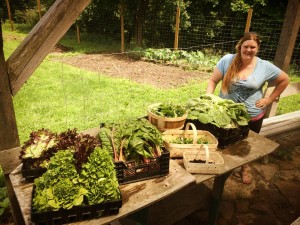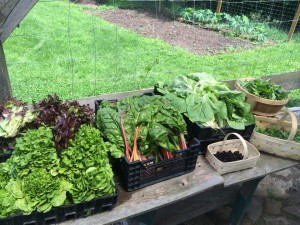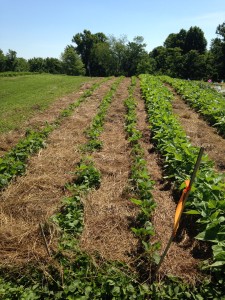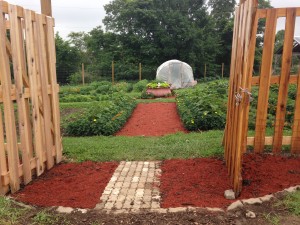New Vrindaban Garden Manager Takes Step Closer to Sustainable Vision
New Vrindaban Garden Manager Takes Step Closer to Sustainable Vision
By Madhava Smullen
Back when she started visiting New Vrindaban at age sixteen, admiring the Rose Gardens at Prabhupada’s Palace and thinking it would be her dream job to work there, Kacey Orr could never have predicted how all the pieces would fall into place.
When her grandfather’s farm in Triadelphia, West Virginia was cut into pieces to make way for the Interstate, farming skipped a generation as her father became a teacher. Kacey, too, seemed destined for a different life, running her own salon. But she felt unfulfilled, and in the late 2000s moved to farming full-time on her family’s farm, and selling her organic produce at local Farmer’s markets in Wheeling and Moundsville.
Her success allowed her to go back to West Liberty University to finish her B.A., for which she wrote a comparative geographical study of Vrindavana, India, and New Vrindaban, West Virginia in 2011. She also began visiting the spiritual community more regularly again, and made friends amongst the community members.
Then at a farmers’ market, she met Madhava Gosh, an agriculturist at New Vrindaban since 1974. Impressed by the news coverage Kacey had gotten for competing in a national farming competition, he invited her to apply for an opening at the community.
Cutting down growing at her own farm to just what she needed for her family, Kacey became New Vrindaban’s full-time Garden Manager in March 2014.
Local food production was, of course, a major goal for New Vrindaban’s founder Srila Prabhupada, and was emphasized in the community from its inception in 1968 until 1979. But in the 1980s and ‘90s it began to taper off and then all but disappeared, until a smaller scale of farming was re-introduced in 1998 by the Small Farm Training Center.
Since 2014, ECO-Vrindaban, a non-profit organization, has been continuing and expanding the Training Center’s program. By caring for New Vrindaban’s forty-eight cattle, milking its eight dairy cows and developing sustainable agriculture, ECOV has been realizing Srila Prabhupada’s vision of self-suffiency and simple living for the community.
And now, as the organization brings in Kacey with her commitment and expertise, community members hope to get closer to that vision than they’ve been in a long time.
Kacey isn’t working alone: she’s gathered a staff of four local people with farm experience and a major interest in sustainability, including some ecology students. And they’re aided by volunteers including local children’s book author Marty Wach, Madhava Gosh as a consultant, and many other New Vrindaban devotees.
They have a lot of work to do. New Vrindaban has three gardens: the five-acre Garden of Seven Gates, the half-acre Teaching Garden, and a small meditation garden behind the temple.
“I have a completely new crew, and this is completely new ground for me,” says Kacey. “It took me years to figure out my ground on my own property. So this year is a lot about learning, exploring and figuring things out.”
It’s a lot about action, too. The garden crew have already put up eight-foot fences and smaller ground-level fences around both main gardens to keep out deer, rabbits, and groundhogs.
In the larger Garden of Seven Gates, they have either planted or are planning to plant during the summer one thousand sweet potatoes, 300 tomatoes, 200 peppers, and 50 basil, as well as squash, snap peas, shell peas, green beans, and organic soybeans for edamame.
Amongst these they’re also planting “cover crops” – plants that act like “green manure” to revitalize the soil – such as buckwheat, Daikon radishes and cowpeas.
“We’re also trying some new things to see what works well,” says Kacey. “There’s ornamental eggplant, large organic edible sunflowers, and quinoa is something I’m very interested in too. It works well at high elevation, can handle drought, and is a whole grain.”
In the Garden of Seven Gates there are also grapes and perennial berries such as raspberries, blackberries, gooseberries, bush cherries, goji berries, honeyberries, and blueberries.
Meanwhile in the Teaching Garden, which is planned as an apothecary garden for medicinal herbs, the crew is planting many flowers for the presiding Deities of New Vrindaban, Sri Sri Radha-Vrindabanchandra, including lilacs, hydrangeas, butterfly bushes, mock-oranges, peonies, zinnias and marigolds.
Finally, in the meditation garden near the temple, there are culinary herbs like oregano, basil, rosemary, sweet sicily and mint.
“It’s an enclosed area, the sort of place you can go to sit and chant your japa, if you want to be outside but undisturbed,” says Madhava Gosh.
For even more food production, Gosh explains, ISKCON New Vrindaban has introduced the concept of contract growing – that is, the temple pays people to grow a particular crop. Currently devotees and other locals including a microbiology professor and a full-time farmer are growing carrots, zucchini, brussel sprouts, broccoli, paste tomatoes, and cilantro for ISKCON New Vrindaban.
While only planting is being done now and harvesting will mostly come later in the season, there are a few crops ready now – asparagus is being harvested, and marigolds will be ready to pick by mid June.
What’s more, Kacey says she’s trying to do a lot of succession planting, spacing her planting at two week or one month intervals “so that we have a steady flow of vegetables, rather than one giant wave.”
In addition, three high tunnel greenhouses, planned for going up before the end of the year, will “extend the seasons,” allowing the gardeners to plant crops ahead of time and then harvest them throughout the winter.
“The goal is to supply all the veggies for the thirty or so people being fed by the temple kitchen during the week,” says Madhava Gosh. Gardeners and cooks will work together to ensure that fresh, locally grown vegetables are also available for the Deity kitchen and Govinda’s restaurant.
Kacey hopes to be able to reach this goal, and be “at least producing some food and flowers year around,” within the next five years. Meanwhile the 200 fruit trees the crew planted this spring should also see a yield.
“It takes a while for fruit trees to produce, but when we hit the five-year mark, we should be producing much of our own fruit,” says Kacey.
Despite the challenges of weather and a new environment, Kacey is glad to be working at New Vrindaban, with its strong support staff and pre-existing infrastructure.
“I’m so lucky to have this opportunity,” she says. “To have this kind of environment and infrastructure, and to work with a community that has a sustainability goal and a long-term plan.”
There’s always plenty to do towards this plan in the community gardens, no matter the season, and Kacey is always eager for people to volunteer as much – or as little – as they’d like. To make your contribution, contact her at korr.ecov@gmail.com or, just find her in the gardens!






